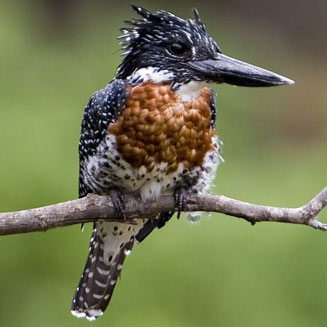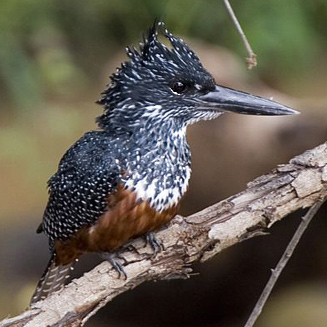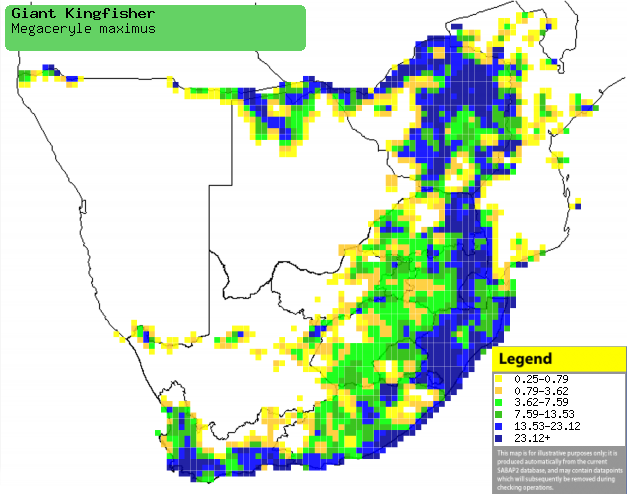|
Ceryle maxima (Giant
kingfisher)
Megaceryle maximus (Giant kingfisher) [= Megaceryle
maxima] Reuse visvanger [Afrikaans]; Reusevisvanger [Afrikaans]; Uxomoyi
[Xhosa]; isiVuba [Zulu]; Esompwaningi [Kwangali]; Seinoli (generic term for
kingfisher) [South Sotho]; Tshololwana (generic term for kingfisher) [Tsonga];
Mmatlhapi, Seinôdi (generic terms for kingfisher) [Tswana]; Afrikaanse
reuzenijsvogel [Dutch]; Martin-pêcheur géant [French]; Riesenfischer,
Rieseneisvogel [German]; Pica-peixe-gigante [Portuguese]
Life
> Eukaryotes >
Opisthokonta
> Metazoa (animals) >
Bilateria >
Deuterostomia > Chordata >
Craniata > Vertebrata (vertebrates) > Gnathostomata (jawed
vertebrates) > Teleostomi (teleost fish) > Osteichthyes (bony fish) > Class:
Sarcopterygii (lobe-finned
fish) > Stegocephalia (terrestrial
vertebrates) > Tetrapoda
(four-legged vertebrates) > Reptiliomorpha > Amniota >
Reptilia (reptiles) >
Romeriida > Diapsida > Archosauromorpha > Archosauria >
Dinosauria
(dinosaurs) > Saurischia > Theropoda (bipedal predatory dinosaurs) >
Coelurosauria > Maniraptora > Aves
(birds) > Order: Coraciiformes >
Family: Cerylidae
 |
 |
|
Giant kingfisher male, Kruger National Park, South
Africa. [photo Trevor Hardaker ©] |
Giant kingfisher female, Kruger National Park,
South Africa. [photo Trevor Hardaker ©] |
The Giant kingfisher is fairly common in southern Africa, and
is found mainly in South Africa and Zimbabwe, living in many types of aquatic
habitats. It feeds mainly on crabs, with fish largely making up the rest of its
diet. Both sexes excavate the nest, which takes about 7 days, and is dug into
vertical sandbanks. Amazingly, they can excavate tunnels as long as 8.45m!. It
lays 3-5 eggs, which are incubated by both sexes, for 25-27 days. The nestlings
are fed mainly by the male, once every 48-213 minutes. They seem to stay in the
nest for about 37 days, after which they are still dependent on their parents
for at least 21 days.
Distribution and habitat
Occurs across much of sub-Saharan Africa, including
southern Africa, where it is fairly common
in northern Namibia (including the Caprivi Strip), northern and eastern
Botswana, Zimbabwe, central and southern Mozambique and South Africa. It can live in almost any water
body with enough food and overhanging branches, such as streams, rivers,
estuaries, seashores, sewage ponds and water furrows.
|
 |
|
Distribution of Giant kingfisher in southern
Africa, based on statistical smoothing of the records from first SA Bird
Atlas Project (©
Animal Demography unit, University of
Cape Town; smoothing by Birgit Erni and Francesca Little). Colours range
from dark blue (most common) through to yellow (least common).
See here for the latest distribution
from the SABAP2. |
Food
It feeds mainly on crabs, with fish dominating the rest of its diet. It normally hunts from perches in tree
canopies, where it searches for prey. Once the prey is located it dives into the
water, sometimes immersing itself completely. The following food items have been
recorded in its diet:
- Vertebrates
- crabs
- Potamonautes perlatus (Cape river crab)
- fish up to 17.7cm long
- frogs
- clawed toads
- Xenopus (Platannas)
- Aquatic invertebrates
Breeding
- Both sexes excavate the nest in about a week, consisting of a burrow dug into
a
vertical sandbanks close to the waterline. It consists of a
0.9-8.45 m long tunnel, ending in a 20-60 cm wide unlined chamber.
- Egg-laying season is normally from July-January, peaking from August-October.
- It lays 3-5 eggs, which are incubated for 25-27 days by both sexes.
- The nestlings are fed mainly by the male every one to four hours.
They probably stay in the nest for about 37 days, after which they are still
dependent on their parents for at least 21 days.
Threats
Status uncertain, although it is fairly common in protected
regions. Its population seems to be decreasing in certain areas, probably due to
loss of potential nest sites.
References
-
Hockey PAR, Dean WRJ and Ryan PG (eds) 2005. Roberts
- Birds of southern Africa, VIIth ed. The Trustees of the John Voelcker
Bird Book Fund, Cape Town.
|
